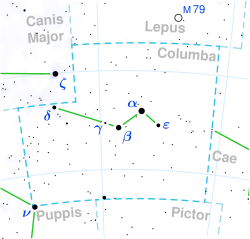| Observation data Epoch J2000 Equinox J2000 | |
|---|---|
| Constellation | Columba [1] |
| Right ascension | 05h 14m 28.84578s [2] |
| Declination | −35° 58′ 37.1904″ [2] |
| Apparent magnitude (V) | 5.73±0.01 [3] |
| Characteristics | |
| Evolutionary stage | Red giant branch [4] |
| Spectral type | G8 III [5] |
| B−V color index | +1.01 [6] |
| Astrometry | |
| Radial velocity (Rv) | 13.2±2.9 [7] km/s |
| Proper motion (μ) | RA: +11.005 mas/yr [2] Dec.: +13.944 mas/yr [2] |
| Parallax (π) | 6.046±0.0316 mas [2] |
| Distance | 539 ± 3 ly (165.4 ± 0.9 pc) |
| Absolute magnitude (MV) | −0.16 [1] |
| Details [8] | |
| Mass | 3.42±0.14 M☉ |
| Radius | 16.2±0.4 R☉ |
| Luminosity | 144±4 L☉ |
| Surface gravity (log g) | 2.68±0.12 cgs |
| Temperature | 4,970±49 K |
| Metallicity [Fe/H] | +0.04±0.04 dex |
| Rotational velocity (v sin i) | 2.3±1.2 [9] km/s |
| Age | 490 [10] Myr |
| Other designations | |
| 6 G. Columbae [11] , CD−36°2127, CPD−36°676, GC 6421, HD 34266, HIP 24426, HR 1721, SAO 195683 [12] | |
| Database references | |
| SIMBAD | data |
HD 34266, also known as HR 1721 is a solitary, [13] yellow hued star located in the southern constellation Columba, the dove. It has an apparent magnitude of 5.73, [3] making it faintly visible to the naked eye under ideal conditions. Based on Gaia DR3 parallax measurements, the object is located 539 light years away. [2] It appears to be drifting away from the Solar System, having a heliocentric radial velocity of 13.2 km/s . [7]
This is an evolved giant star that is currently on the red giant branch, [4] fusing hydrogen in a shell around an inert helium core. It has a stellar classification of G8 III. [5] HD 34266 is calculated to be 490 million years old, [10] almost 10 times younger than the Sun. However, it already left the main sequence due to a mass of 3.42 M☉. [8] HD 34266 has expanded to 16.2 times the Sun's girth and now radiates 144 times the luminosity of the Sun from its photosphere at an effective temperature of 4,970 K . [8] HD 34266 has a near solar metallicity and spins modestly with a projected rotational velocity of 2.3 km/s . [9]
